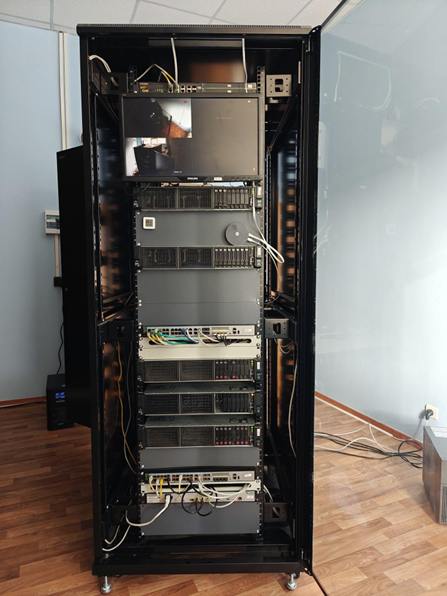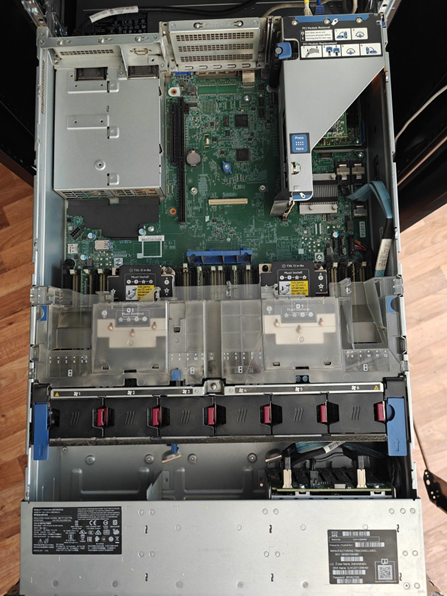Research Center "Data Science in Astrophysics" named after Z.Zhanabayev
The center was opened by the decision of the meeting of the Scientific Council No. 4 dated December 20, 2023, based on the order of the Rector of Al-Farabi KazNU No. 10 dated January 10, 2024.

Aldiyar Agishev, manager of the "Data Science in Astrophysics" Center, PhD in Physics and Astronomy, acting Associate Professor of Al-Farabi KazNU
The "Data Science in Astrophysics" Center was established with the goal of bringing together leading research groups from the Kazakh National University in the fields of observational astronomy, astrophysics, and the application of data science methods (modern and innovative techniques) in these areas.
Scientific and Educational Activities
The "Data Science in Astrophysics" Center is actively involved in educational activities, including participation in the training of the next generation of specialists. The center conducts scientific research and educational projects with the involvement of undergraduate students, master’s and doctoral students from the Faculty of Physics and Technology, as well as high school students with advanced science studies.
The center's team is working on the development of educational and methodological materials for key areas in astronomy, astrophysics, and data science, contributing to the development of educational programs and the improvement of teaching.
Regular open seminars are held, covering both local and international participation, attracting leading scientists from other countries for the exchange of experience and knowledge. These events contribute to the integration of the local scientific community into the global context and the development of international collaboration.
Research Activities
The "Data Science in Astrophysics" Center conducts cutting-edge research in observational astronomy, astrophysics, and the application of data science methods to address pressing scientific problems. The center focuses on the following areas:
Stellar Evolution and Structure – determination of fundamental parameters of systems based on modeling of object light curves.
Modeling Light Curves of Variable Stars – analyzing observational data and constructing models to study their behavior.
Hydrodynamic Modeling – description of the structures and dynamics of disks in binary systems based on numerical simulations using the SPH (smoothed particle hydrodynamics) method.
Doppler tomography – is an observational method for describing disk structures that allows one to reconstruct the distribution of radiating matter in the system in radial velocity coordinates using phase-resolved spectral data.
Spectral Line Modeling – modeling the characteristics of electromagnetic radiation coming from observed systems to study the properties of the shells of the objects under study.
The center is currently conducting several ongoing research projects funded by the Science Committee of the Ministry of Science and Higher Education of the Republic of Kazakhstan (SC MSHER KZ).
The results of the center's research are regularly published in high-ranking international scientific journals indexed in Scopus and Web of Science.
The center also actively participates in international scientific collaborations, presenting its research findings at world-class conferences. In addition, the center organizes scientific conferences, providing a platform for knowledge exchange and collaboration among scientists from different countries.
In 2024, as part of the celebration of the 90th anniversary of the university, an international conference “Hot Stars. Life with Circumstellar Matter” (https://conf.astrokaznu.kz) was organized and held. There about 90 scientists took part, including 50 leading astrophysicists from 20 countries (USA, Canada, Latin America, Russia, Europe, China and others).
Current projects
Grant funding of young scientists for scientific and (or) scientific and technical projects for 2023-2025 (Ministry of Science and Higher Education of the Republic of Kazakhstan):
AP19578879 "Study of Observational Manifestations of FS CMa Type Stars by Computer Simulation", under the direction of A.T. Agishev
Grant funding for scientific and (or) scientific and technical projects for 2023-2025 (Ministry of Science and Higher Education of the Republic of Kazakhstan):
AP19678376 "Physics of accretion flows in cataclysmic variables with different accretion rates", under the direction of S.A. Khokhlov
Brief description
Computing Cluster for Astronomy and Astrophysics needs of al-Farabi KazNU.
The computing system cluster consist of physical servers. Supplemented by a remote cloud infrastructure, is built on the principle of high availability and fault tolerance.
This architecture satisfies technical needs and is scalable both vertically and horizontally.
The flexibility and modularity of the cluster structure is ensured by a unified control system through distributed power and access systems. In this way, full functionality of computing nodes is achieved 24/7, backup, migration, data storage and access with the possibility of “hot” replacement and deployment as exacting systems so as entire nodes.
The access system is built through a main 1Gbps channel using a secure SSL VPN topology. A backup 4G radio channel with a speed of 50Mbps is deployed through a Firewall with an external, public IP address. The cloud part is deployed on rented virtual hosting (Microsoft OneDrive) to support data distribution and access.
Computing node is a set of virtual machines on a common hypervisor platform (in particular, HYPER-V, in some moments ESXi) built above of shared resources, distributed across physical servers (Xeon processors, RAM and hard drives in a RAID array).
Power is provided by independent power supplies and a backup system. Power management system support a remote access feature. The machine-to-machine connection within the domain is built on 10Gbps interfaces. The network infrastructure is built through link aggregation and connection redundancy. Broadcast VLAN domains separates the power management system with monitoring sensor system, management subnet and access subnet.
We use our own Linux-shell based script to parallelizing calculations.
|
|
|
|
|
HP Enterprise ProLiant DL380 Gen10 Plus (support PCIe 4.0), 2U Rack. Processor: 112 threads 2.60 GHz, (max. 3.5 GHz) 2x Intel Xeon Gold 6330, 42M Cache, 28 cores, 56 threads each. GPU: 1xNvidia A2 RAM: 128 GB, 4x32GB, DDR4-3200MHz. Storage: 2.8 TB, 3x960GB SSD on 8xSFF bay with MR416i-p NVMe/SAS 12G hardware RAID controller. Network: 2x10GE (SFP+, DAC, access), 1x1GE (management). Power supply: 1x1600W and 1x800W (backup power). |
Computing Cluster for Astronomy and Astrophysics has the following characteristics:
Computing Resources
In total, the following resources are available:
-- 464 threads with 2.6 GHz (on 10 physical CPUs, Xeon Gold 62xx/63xx series processors)
-- 1 GPU (Nvidia A2)
-- 576 GB Memory (DDR4, 2666 MHz)
-- 23 TB Storage (SSD / SAS drives on hardware RAID)
Cluster hardware consists of 4 HP Enterprise DL380 Gen10 / Gen10 Plus units
Access capabilities
-- SSH and RDP (VNC on demand) via Public IP Address
-- Access to “user data” is also possible through the Microsoft Сloud (1 TB, type of file hosting service) via Shared links.
Software and hardware topology
-- Host OS based on Linux (Ubuntu 18.04 LTS)
-- Virtualization on Hyper-V Server 2019
-- Internet connection (Main up-link, Access LAN) interface type is 1 Gigabit Ethernet (1 GE, the best measured ping about to 2-5 ms and speed is 750 Mbpc, according to speedtest.net service)
-- Reserved 4G cellular network is available (50 Mbps, it is also used for Public IP Access)
-- Main power supply 6.5 kW (Backup power 2.2 kW)
-- Inter cluster communication, via 10GBASE (SFP+, DAC)
-- Management VLAN network based on 1 GE interfaces with remote access via Forti Gate SSL VPN.
-- Firewalls (NGFW), system monitoring tools, routing and switching features such as link aggregation and connection redundancy are implemented.
-- Scalability is possible by both vertically and horizontally.
O&M (operations and maintenance) features
-- OS workload checkpoints
-- Backup and migration for OS
-- Cloning and imaging with current configurations and built-in applications.
-- Fast deployment features for OS and computing nodes
-- Hot-swappable hardware components of serves in the cluster
Center Director:
Agishev Aldiar Talgatovich, Director of the "Data Science in Astrophysics" Center, PhD in "Physics and Astronomy", acting associate professor
===============================================
LABORATORY "DATA ANALYSIS IN ASTROPHYSICS" – ROOM 533
Laboratory Head:
Khokhlov Serik Anatolyevich , PhD in "Physics and Astronomy"
Position: Senior researcher at the laboratory of Data Analysis in Astrophysics (KazNU); acting professor of the Department of Electronics and Astrophysics (KazNU)
Research Interests: spectral analysis; B[e] stars; Be stars; post-AGB stars; spectral energy distribution.
ORCID: 0000-0001-5163-508Х
Scopus Author: 57193160477
e-mail: skhokh88@gmail.com
Research team:
Vaidman Nadezhda Leonidovna, MSc in "Physics and Astronomy"
Position: junior researcher at the laboratory of Data Analysis in Astrophysics (KazNU); junior researcher at the laboratory of Physics of Stars and Nebulae (FAI); observer at Tien-Shan Astronomical Observatory (FAI)
Research Interests: Observational astronomy; primary data processing; spectral analysis; Be stars; stellar evolution; MESA
ORCID: 0000-0002-7449-0108
Scopus Author: 58554640500
e-mail: nva1dmann@gmail.com
Gabitova Ilfa Azamatovna , PhD candidate (3rd year) in "Physics and Astronomy"
Position: junior researcher at the laboratory of Data Analysis in Astrophysics (KazNU)
Research Interests: spectral analysis; Be stars; doppler tomography; spectral energy distribution
ORCID: 0000-0002-5328-8568
Scopus Author: 58554782700
e-mail: ilfa3110@gmail.com
Nurmakhametova Shakhida Tashmakhomedovna , 4th-year undergraduate student in "Physics and Astronomy"
Position: engineer at the laboratory of Data Analysis in Astrophysics (KazNU)
Research Interests: primary data processing; spectral analysis; photometry; post-AGB stars
ORCID: 0009-0005-6851-7270
e-mail: shahidanurmahametova@gmail.com
Agishev Damir Talgatovich, PhD candidate (1st year) in "Physics and Astronomy"
Position: junior researcher at the laboratory of Data Analysis in Astrophysics (KazNU)
Research Interests: spectral line modeling; hydrodynamic modeling; SPH
ORCID: 0009-0008-7289-1347
e-mail: agishev.pluto@gmail.com
=========================================================
"DATA PROCESSING AND STORAGE CENTER" LABORATORY – ROOM 529
Laboratory Head:
Aldiar Talgatovich Agishev, PhD in "Physics and Astronomy"
Position: Senior Researcher, Acting Associate Professor at the Department of Electronics and Astrophysics (KazNU)
Research Interests: Cluster computer administration, computational resources, SPH (Smoothed Particle Hydrodynamics) modeling
ORCID: 0000-0001-9788-7485
Scopus Author: 57201661110
e-mail: aldiyar.agishev@gmail.com
Research team:
Khokhlov Azamat Anatolyevich , PhD in "Physics and Astronomy"
Position: postdoctoral researcher, senior lecturer, Huawei HCIP-Datacom Instructor
Research Interests: spectral analysis; B[e] stars; spectral energy distribution.
ORCID: 0000-0001-6987-9058
Scopus Author: 57945306100
e-mail: kh.azamat92@gmail.com
=========================================================
International employees:
Dr. Anatoly S. Miroshnichenko
Position: Professor of Physics and Astronomy, UNCG, USA
Research Interests: Expert in stellar astrophysics, specialist in spectral data modeling
ORCID: 0000-0003-2526-2683
Scopus Author: 7003818343
e-mail: a_mirosh@uncg.edu
Dr. Sergey Zharikov
Position: Investigador Titular "B" T.C., OAN IA UNAM, Mexico
Research Interests: Expert in stellar astrophysics, specialist in stellar system modeling, Doppler tomography
ORCID: 0000-0002-3833-1038
Scopus Author: 7005549133
e-mail: zhar@astrosen.unam.mx
Publications:
2024:
- Nodyarov, A. S., Miroshnichenko, A. S., Khokhlov, S. A., Zharikov, S. V., Agishev, A. T., Gabitova, I. A., Vaidman, N. L., & Manset, N. (2024). Properties of Galactic B[e] Supergiants. X. Refined Orbit and Fundamental Parameters of the HD 327083 Binary System. The Astrophysical Journal, 968(2), 52. https://doi.org/10.3847/1538-4357/ad4a63
- Gabitova, I. A., Miroshnichenko, A. S., Zharikov, S. V., Amantayeva, A., & Khokhlov, S. A. (2024). Doppler Tomography of the Circumstellar Disk of the Be Star κ Draconis. Galaxies, 12(3), 23. https://doi.org/10.3390/galaxies12030023
- Miroshnichenko, A. S., Danford, S., Zharikov, S., Aarnio, A., Prendergast, P., Khokhlov, S. A., Gabitova, I. A., Amantayeva, A., Vaidman, N. L., Baktybayev, S. S., Andronov, I. L., Chinarova, L. L., & Usenko, I. A. (2024). A variety of binary targets for small telescopes. Contributions of the Astronomical Observatory Skalnate Pleso, 54(2), 47–57. https://doi.org/10.31577/caosp.2024.54.2.47
- Miroshnichenko, A. S., Chari, R., Danford, S., Prendergast, P., Aarnio, A. N., Andronov, I. L., Chinarova, L. L., Lytle, A., Amantayeva, A., Gabitova, I. A., Vaidman, N. L., Baktybayev, S. S., & Khokhlov, S. A. (2023). Searching for Phase-Locked Variations of the Emission-Line Profiles in Binary Be Stars. Galaxies, 11(4), 83. https://doi.org/10.3390/galaxies11040083
54g54g54




.jpeg)